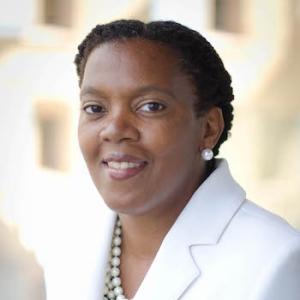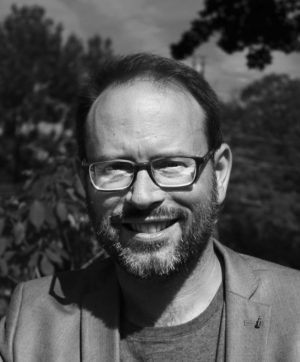Resources

“Write your name, for me, please,” she asked, a sturdy index finger tapping on a piece of paper, on the table at my aunt’s house. She was my paternal grandmother, Johanna, or Teacher Kate, as many people called her, and she was visiting her family in Toronto from Guyana. She would have been in her sixties then, a compact Black woman with flawless skin, a kind, steady gaze, and a resonant alto speaking voice. You could hear the mixture of crisp and precise British-influenced English that would have been expected of schoolteachers of Teacher Kate’s generation, born before World War I, in a corner of Amazonia and at the edge of the British Empire. You could also hear the rhythms of Caribbean creole speech, reflecting Guyana’s cultural legacy of majority populations descended from enslaved Africans and indentured folk from the Indian subcontinent and China, among others. Teacher Kate’s work in classrooms with children began before 1930 as a pupil-teacher, a form of teaching apprenticeship of young teenagers that was regularly practiced in the English-speaking Caribbean, in the early decades of the twentieth century. “Write your name, for me, please.” It was a directive, an invitation, and a question all rolled into one as we gathered around my aunt’s dining table. This was the late 1970s, pre-Internet, and I was in my early teens and already in high school. At that point, I had attended school for almost a decade split between Antigua and Canada, having spent my infancy in England, the country of my birth, as a child of the Windrush migration. The late 1970s was a magical transitional time in Black musical cultures as it was the era of the earliest commercial hip hop recordings, disco, funk, and R n’ B. We also listened to reggae, dancehall, calypso, and soca, Caribbean popular musical genres as well, new wave, punk and pop and rock n’ roll on AM and FM radio—our musical choices reflecting our transnational existence between recent Caribbean memories, the larger social context of a rapidly changing Canadian cultural landscape, contemporary Black Toronto realities in the Caribbean diaspora with close sonic and familial ties to major urban centres in the US and England to which Caribbean people had migrated. My friends and I emulated the look of the Pointer Sisters, The Emotions, or women lead vocalists in Chic. In our stylistic ambitions, we existed on a continuum of retro 1940s, church, and our imagined Studio 54. Our looks were achieved through making our own clothes with Simplicity and Butterick patterns, and reworking and mending heavily discounted seconds (discarded mass-produced clothing with what we considered minor and correctible mistakes like crooked seams and missing buttons) purchased cheaply in the garment district in downtown Toronto. That day I wore a belted, light beige, cap-sleeved dress in a shimmery fabric. My hair was still natural, a few years away from its 1980s curly perm, and picked out into a ‘fro. This was the late 1970s and in Black diasporic girl stylistic cultures in my corner of Toronto afros, cornrows, and other natural styles still reigned supreme with the occasional hot comb pressed straight styles for special occasions. I wondered why Teacher Kate would want me to write my name as an introduction to who I was as a student and her granddaughter. Why not ask me to read out loud or to recite memorized passages of poetry, bible verses, or dramatic plays? I had already had lots of practice in public speaking at school and in church, in Canada, where my first recitation was Langston Hughes’ poem “Freedom.” I remembered the church assembly in the Jamaican Pentecostal congregation that met in the basement of a mainstream Protestant church in our Toronto neighbourhood, now called Little Jamaica. We were Anglicans but my mother insisted that we go to the church down the road and around the corner from our house that we could reach without crossing a major intersection, and where our friends from school, recently arrived kids from the Caribbean, also went to church. “Write your name for me, please.” So, I picked up the pen and I wrote my first name in cursive and print. “Write your whole name.” I wrote my first and last name. My grandmother inspected my writing and complimented it while also giving some pointers to improve the cursive. “Write it larger,” she said. I wrote my name several times and each time I did so with more confidence than earlier versions. Now, I wrote my name every day in school on assignments and had done so for years. My friends and I even practiced our autographs. I had written my name years ago in my British passport as an elementary school student. This occasion, however, felt different. In the analog world of the late 1970s, just a few years before the launch of the digital age, my grandmother was inviting me to come to the table of knowledge, to take up space, and to write myself into the narrative in my own hand, boldly and confidently and with style. Words mattered. I got it. I created my signature in that moment with its large cursive letters. Teacher Kate lived for over three decades after that night, in total just over a hundred years. By the late 1970s she had already taught several generations doing the hard work in the post-slavery and British colonial era of the first half of the twentieth century of teaching literacy. Many had entered Guyana and other Caribbean territories as transports of empire through the forced migrations of the slave trade and indentureship, without signature—perhaps an “x,” or even a thumbprint for the latter. I was only Teacher Kate’s student for that one evening but I learned a crucial lesson of accepting the invitation to take my place and to write my name and write myself into being. Photo by Kat Stokes on Unsplash

During the past year, two of my favorite Brazilian writers and educators, Luiz Antonio Simas and Luiz Rufino collaborated on yet another book: Encantamento: Sobre a Política da Vida (Incantation: On the Politics of Life). One of the central affirmations of their work (which follows their previous co-authored publications: A Pedagogy of the Crossroads, An Arrow Through Time, and The Enchanted Science of Macumbas) is that the opposite of life isn’t death—it is desencantamento, or an inability to surrender to a process of incantation. As a verb, incantare evokes our capacity to fuse song and word in an effort to raise our spirits, to spark magic in our imaginations, to invite divine presence. Our capacity to incantate spaces of learning does precisely what theologian Rubem Alves invites us to do: name and invoke the not-yet worlds, so as to break the spells of right-here worlds that continue to abandon, oppress, exclude, and sever from ourselves and our communities of belonging. Incantation as a poetic of resistance allows us to escape, disobey, and ambush the traps set through the colonial matrix of power so that bodies can dare to see, create, invent, and integrate new possibilities freedom, belonging, and liberation through creativity and imagination. Incantation, Simas and Rufino affirm, nests our capacity to move through time, to experience a passage between forms and worlds, to change our points of reference through a politic of life that is rooted in an imprinting of the everyday as rites of reading and writing different poetic routes capable of setting traps to our collective loss of hope and vivacity.[i] In this sense, incantation is an exercise in emergence and survivance that lives and breathes beyond the terrorizing effects of coloniality. It’s the commitment to movement, occupation, visibility, insertion, and participation. It’s the creative force that travels through crossroads of knowledge-making, confronting hierarchizations produced by ontological, epistemological, and semiotic violences. Art, as I understand it, has a tremendous power to forge incantatory pathways of resistance because of its capacity to dis-educate us from disciplinary molding. It reverberates and discloses to us that which is hidden in our interior recesses in embodied, striking, and visceral ways. It can help us re-educate our affections, as Paulo Freire puts it, or work a kind of magic in our souls, as bell hooks states. It also inspires us to name the world as we see it, and to find a poetic tongue when the language we know fails us. It helps us resist, heal, connect, conjure, and tend to all our relations. As generative clearings, the arts are sites for world-making, for dreaming, rehearsing, and choreographing new possibilities of being and intervening in the world. When we immerse ourselves in acts of artmaking, we have the opportunity to access the visceral, the somatic life of the body, its reflexes, limits, intuition, responses, desires, needs, and its alchemies. When we encourage and invite students to in-corporate artmaking processes as they engage readings, discussions, and bodies of knowledge, we participate in this politic of incantation. A student’s performance and ritual entitled “Disposable Beauty” still stands as one of the most profound and generative projects to which I have been witness. As a final integrative assignment, the performance consisted of placing delicate flower arrangements throughout locations in her neighborhood that were marked by abuse, violence, and abandonment. Such poetic gestures in vulnerable spaces in the city sought to raise awareness of our transience, interdependence, and negligence in the face of injustice. The flower assemblages were made out of blossoms and foliage that flower shops would throw away at the end of the day. This poetic gesture both incantated and resisted the (i)logic of degradation, disposability, oppression, and inequity by orienting herself and participants in acts of creative wonder. Through her invocation of not-yet worlds, she extended a gesture of care, of regard, of re-worlding, refusing to be desencantada with the world around her. At the end of these performances, she invited folks to partake in tea ceremonies that were rooted in offering the gift of reciprocity, spiritual care, regard, and a warm cup of tea. As a poetic of incantation, her artistic gestures imbued spaces of desolation, disposability, and abandonment with love, presence, and beauty through a practice that integrated the semester’s resources, readings, discussions and questions with her own wisdom, creativity, and spiritual sensibilities. I return to this experience often to remind myself to continuously ask how many of the assignments outlined in my syllabi impede or foster poetic and incantatory experimentations. Notes [i] See Luiz Antonio Simas and Luiz Rufino, Encantamento: Sobre Política de Vida (Rio de Janeiro, RJ: Morula Editorial, 2020). Photo Credit: Miguel Garcia Saaved - stock.Adobe.com

Delvyn Case · Ruach (Revised Version) The Hebrew word Ruach means both “breath” and “spirit.” Fundamental to this word (and to the Greek analogue, pneuma, which also is used in both ways) is a paradox. The notion of “spirit” denotes something ineffable and invisible - yet something that is always ready to break through and make itself known in a transformative way. Catholic mystics, African griots, and Christian Pentecostals are well-known examples of religious people who - when filled with the “spirit” – sing, dance, pray, feel, or see things that are amazing, powerful, and even out of their control. In the same way, “breath” is something simultaneously ineffable and invisible – yet also so fundamentally physical that our bodies do it without our conscious thought. We usually only become aware of our breathing when we experience something surprising or particularly important: when something beautiful makes us catch our breath, our something frightening makes us cry out in terror. In the same way, we are not usually aware of our “spirit” except in special circumstances: in a religious or spiritual state, for example, or when we have to call upon something deep within us in order to create – or to endure. This piece, Ruach, confronts this paradox by bringing to our awareness many different ways “breath” and “spirit” can become sonically and dramatic present. Throughout the piece the performers are asked to make various kinds of breath sounds with their instruments and their own voices, blurring the line between music and sound. Overall, the piece emphasizes idea of the spirit as a powerful force that is surprising, shocking, and fundamentally resistant to control.
Wabash Center Staff Contact
Sarah Farmer, Ph.D
Associate Director
Wabash Center
farmers@wabash.edu